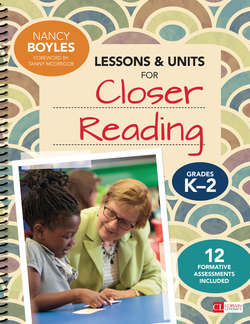Читать книгу Lessons and Units for Closer Reading, Grades K-2 - Nancy Boyles - Страница 36
На сайте Литреса книга снята с продажи.
How the Assessments Are Embedded in Weekly Instruction
ОглавлениеEffective teachers assess as they instruct. We continually watch for clues in our students’ literacy behaviors and performances that alert us to what our students know and are able to do. All of these observations, whether derived from students’ oral or written responses, become our data, the evidence we use to plan the teaching next steps. This is the essence of formative assessment: to inform. But data-driven instruction needs a coherent set of grade-level expectations, and here is where the English language arts (ELA) standards come in. The standards help us know what our goals are, the skills we are meant to be teaching, and they are a means of tracking students’ progress in the primary grades. By aligning the formative assessments in this book to standards, they become rooted in a more universal, research-based foundation.
Courtesy of Rick Harrington Photography
In kindergarten, first, and second grades our purpose is not to sum up students’ performance with a score but to build on what they can do right now to move them to the next level of achievement as efficiently as possible. Why are scores not particularly useful? Because young children’s cognitive capacities change so rapidly in the early grades that today’s score may be next week’s old news.
Within each and every unit I offer two types of tools that can be used to inform instruction. These tools are most typically used in the close reading follow-up lessons on Days 3 and 4 of the weekly plan. This means a total of eight lessons per unit.
During Reading: A card, a set of cards, or a chart helps students track their thinking using oral response during the lesson.
After Reading: A Reader Response Frame guides written responses after reading.
Under each standard, beginning on page 25, I explain how to use the particular card, set of cards, or chart to monitor your students’ understanding during close reading. Following is a general explanation of the purpose of the cards and Reader Response Frames and how to use them.
